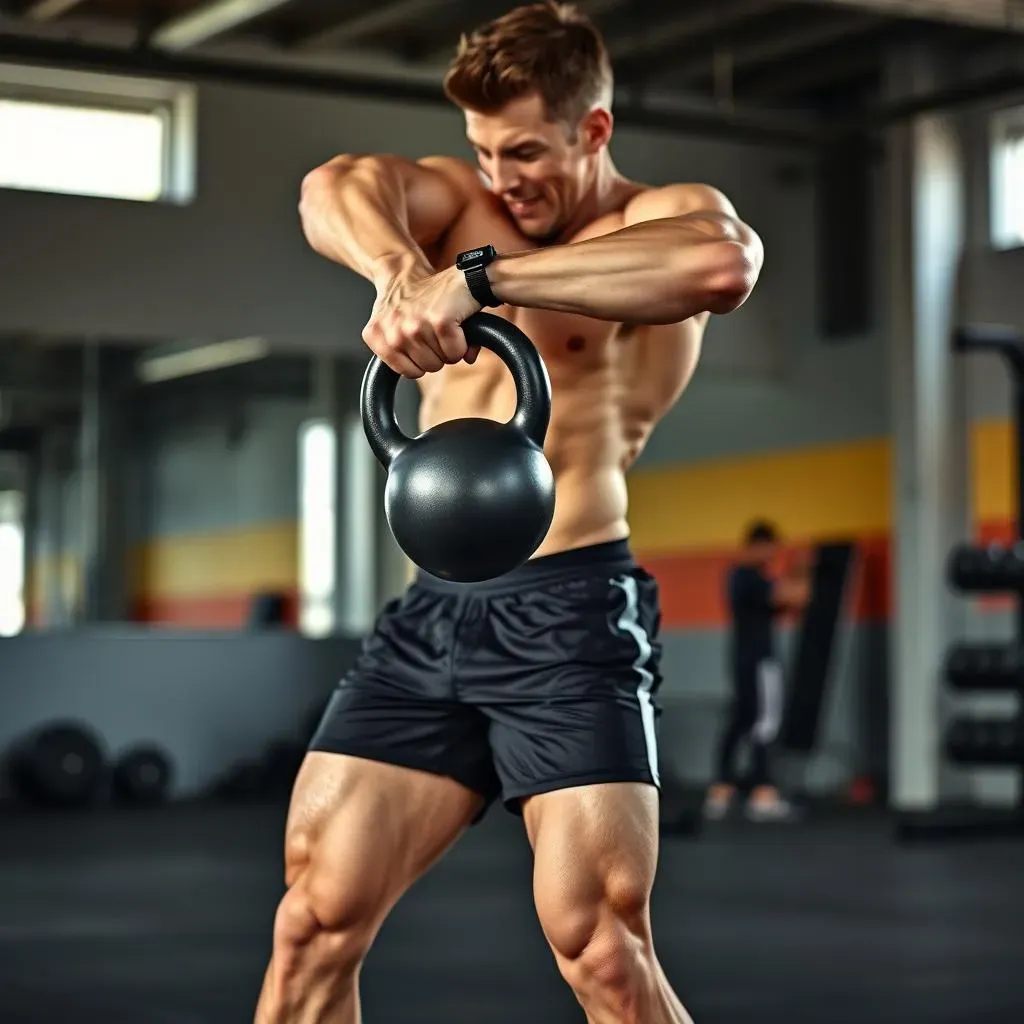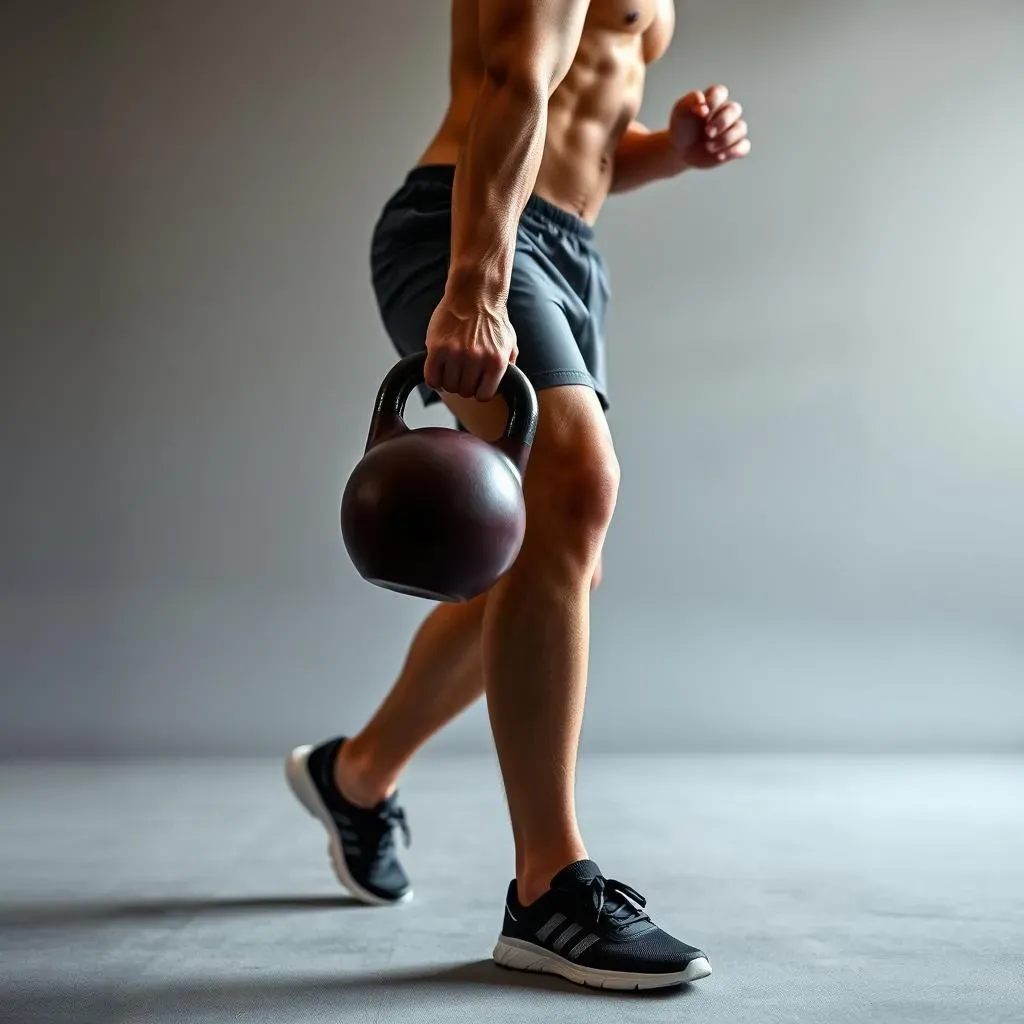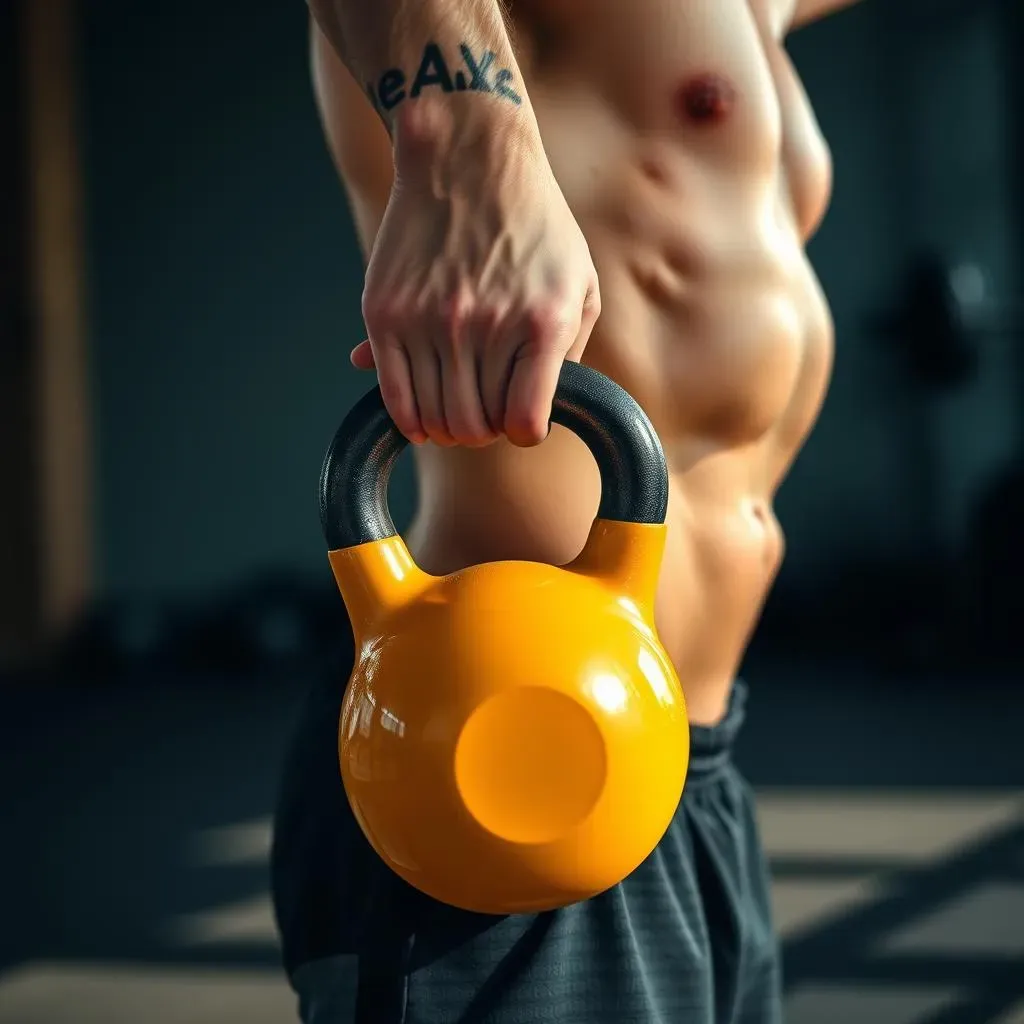Table of Contents
Tired of endless crunches and sit-ups that leave your neck aching? What if I told you there’s a way to work your abs that's not only effective but also gets you on your feet? Forget those floor-bound routines because we're diving into the world of the kettlebell standing abs workout. This isn't your average core session; it's a dynamic, full-body engagement that will challenge your balance, strength, and endurance all at once. We’ll explore why standing ab exercises are a total game-changer, and then I’ll walk you through five killer kettlebell moves that will target every nook and cranny of your midsection. Think suitcase marches, halos, windmills, and more – all designed to sculpt and strengthen. And don’t worry, I’ll show you how to put it all together into a workout you can actually do. So, if you're ready to ditch the floor and discover a new way to work your core, keep reading.
Why Standing Kettlebell Abs Workouts are a Game Changer

Why Standing Kettlebell Abs Workouts are a Game Changer
Beyond the Crunch
Let's be real, are you bored with the same old crunches? I know I was. The problem with traditional ab exercises is that they often isolate the muscles, and honestly, they aren't that functional. When do you ever do a crunch in real life? Standing kettlebell workouts, on the other hand, mimic natural movements, engaging your core in a way that translates to everyday activities. Think about it: carrying groceries, reaching for something on a high shelf, even just walking – all these actions require a strong, stable core. And that's exactly what a standing kettlebell workout delivers.
Full Body Engagement
Here's the secret sauce: standing kettlebell exercises aren't just about your abs. They recruit your entire body, from your shoulders to your legs. When you're doing a kettlebell halo, for example, you're not just working your obliques; you're also firing up your shoulders, back, and even your glutes to maintain balance. This means you are getting more bang for your buck, burning more calories, and building a more functional physique. I love that feeling of my whole body working together, it just feels more connected.
Benefit | Traditional Abs | Standing Kettlebell Abs |
|---|---|---|
Muscle Engagement | Isolated | Full-Body |
Functionality | Limited | High |
Calorie Burn | Lower | Higher |
Real-World Strength
It's not just about looking good; it's about feeling strong in your day-to-day life. I remember when I first started doing standing kettlebell workouts, I noticed a huge difference in my overall stability and power. Suddenly, carrying my kid's backpack felt like nothing, and I could move furniture without throwing my back out. These exercises build the kind of core strength that protects your spine, improves your posture, and makes you feel like a superhero in your own life. Trust me, this is the core strength you actually need.
The 5 Best Kettlebell Standing Abs Exercises

The 5 Best Kettlebell Standing Abs Exercises
Standing Kettlebell Suitcase Marches
Alright, let's get into the good stuff. First up, we have the Standing Kettlebell Suitcase Marches. It might sound simple, but trust me, these are a core killer. Hold a kettlebell in one hand, just like you're carrying a suitcase, and start marching in place, bringing your knees up high. The key here is to keep your core tight and your body upright, avoiding any leaning. You'll feel your obliques working hard to stabilize you with every step. I like to imagine I'm walking through a busy airport, trying to keep my suitcase from swinging all over the place. It's a great way to start any workout because it gets your core firing and your blood flowing.
This is not just about lifting a weight and moving your legs; it's about maintaining that rigid core, and not letting the kettlebell pull you to one side. This exercise not only works your abs but also improves your balance and coordination. It's like a sneaky way to get a full-body workout while focusing on your midsection. Start with a lighter kettlebell, and once you get the hang of it, you can increase the weight for an extra challenge.
Kettlebell Halos
Next, we have Kettlebell Halos. This one looks a little different, but it's super effective for targeting your entire core. Hold the kettlebell upside down by the horns (the curved part) close to your chest. Then, slowly circle the kettlebell around your head, keeping your core engaged. It is not about speed; it's about control, and you should feel the burn all around your waist. When I first started doing these, I felt like I was trying to draw a perfect circle with a giant pencil – it was a little awkward, but once you get the hang of it, they become a staple in my routine.
This exercise is fantastic for improving your shoulder mobility too, and it's a great warm-up or cool-down move. Just make sure you're keeping your core tight, and not letting the kettlebell pull you forward. If you feel any strain in your neck, you can reduce the range of motion, making the circles smaller. Keep practicing and you'll get there. It's a great way to get a good burn in a way that feels different from the typical crunch.
Exercise | Primary Muscles Worked | Secondary Muscles Worked |
|---|---|---|
Standing Kettlebell Suitcase Marches | Obliques, Abs | Hip Flexors, Shoulders |
Kettlebell Halos | Obliques, Transverse Abdominis | Shoulders, Upper Back |
Kettlebell Windmills
Now, let's talk about Kettlebell Windmills. This is one of my favorites because it works your core and also improves your flexibility and balance. Stand with your feet a little wider than shoulder-width apart, holding the kettlebell overhead with one arm. Then, hinge at your hips, reaching down towards the opposite foot, while keeping your arm straight up. It's like you're trying to touch the ground with your hand while balancing a kettlebell on the other hand. When I first tried these, I felt like a rusty robot, but with practice, it became surprisingly smooth, and my core felt like it was on fire in the best way possible.
The key here is to move slowly and controlled, not just flopping down. Keep your core tight and your gaze on the kettlebell overhead. If you can't reach your foot, that's okay, just go as far as you comfortably can. It's a great exercise to feel the stretch in your hamstrings as well as working your obliques. It is a full body workout in a single move. Don't be surprised if you feel this in your legs, back, and shoulders, too. It's a great full-body exercise that also hits your core hard.
Kettlebell Standing Abs Workout: How to Put it All Together

Kettlebell Standing Abs Workout: How to Put it All Together
The Workout Structure
Okay, so you've got the moves down, now it's time to put them together into a workout. I'm a big fan of EMOMs, or "Every Minute On the Minute." It's simple, effective, and keeps things interesting. Here’s how it works: you'll perform a specific exercise at the start of each minute, and then rest for the remainder of that minute. For this workout, we're going to do a 5-round circuit, using each of the five exercises we've talked about. That means each exercise will get one minute of work per round, and you have 5 rounds total. It’s a great way to keep the intensity high and your heart rate up. It's like having a mini-challenge every minute, and it pushes you to stay focused.
The 5-Round Circuit
Here’s the breakdown. For each minute, you'll do the following:
- Minute 1: Standing Kettlebell Suitcase Marches (10 reps per side)
- Minute 2: Kettlebell Halos (10 reps per direction)
- Minute 3: Kettlebell Windmills (5 reps per side)
- Minute 4: Kettlebell Hand-to-Hand Passes (10 reps per side)
- Minute 5: Kettlebell Openers (10 reps per side)
Then rest for 60 seconds and start over from the top. Repeat this circuit for a total of 5 rounds. The key is to work hard during your minute, but also pay attention to your form. Don't sacrifice good technique for speed. If you need to take a break mid-minute, that's okay. Just pick back up when you can. This workout is designed to challenge you, not break you. Remember, it’s about consistency, not perfection.
Rest and Progression
Rest is as important as the workout itself, so don’t skip it. Take a 60-second break between rounds to catch your breath and regroup. As you get stronger, you can reduce the rest time or increase the weight of your kettlebell. Remember, it's a journey, not a sprint. It took me a while before I could do 5 rounds without feeling like I was going to pass out. Start where you are, be patient with yourself, and celebrate your progress. And, hey, if you’re feeling super ambitious, you can always add more rounds. Just don't forget to listen to your body, and stop if you feel any pain. It's all about finding that sweet spot where you're challenged, but not overdoing it.
Tips and Tricks for Kettlebell Standing Abs Workout Success

Tips and Tricks for Kettlebell Standing Abs Workout Success
Mastering the Grip
Alright, let’s talk about grip because it's a game-changer with kettlebells. A weak grip can throw off your form and limit the weight you can handle. I see so many people struggling because they're holding on for dear life, which makes everything harder. So, focus on gripping the kettlebell firmly, but not so tight that your knuckles turn white. Think of it like holding a steering wheel: you want a secure grip, but you don't need to strangle it. Chalk can be your best friend if your hands get sweaty, or you can use gloves if you have to, but try to build up your grip strength naturally. I've found that just doing some farmers carries with the kettlebells can make a massive difference, and it doesn't take long to see results. It's like a secret weapon for all your kettlebell exercises.
Also, remember that different exercises will need slightly different grips. For the halos, you'll be holding the kettlebell by the horns, and for the swings, you'll be holding it by the handle. It's important to get comfortable with both. It's all about finding the right balance between a firm grip and a relaxed hold, so that you can move the weight with control and precision. If you are new to kettlebells, start with a lighter weight and focus on your grip, and then slowly increase the weight as your grip gets stronger. Trust me, it will make a huge difference in your workout experience.
Prioritize Form Over Weight
This is crucial: leave your ego at the door. I know it's tempting to grab the heaviest kettlebell you can find, but trust me, it's not worth it if your form suffers. Doing kettlebell exercises with poor form is a recipe for injury, and it won't give you the results you're after. Instead, focus on mastering the movement with a lighter weight. It's okay to start small, and it's actually better to do it right than to lift heavy and risk hurting yourself. I always tell myself that I'm not training to impress anyone; I'm training to get stronger and more functional. And proper form is the key to that.
When you're doing the exercises, pay close attention to your body and how it feels. Are you using your core to stabilize yourself? Or are you relying on your lower back? If you're feeling pain, stop and adjust your form. You can even film yourself to see how you look or ask a friend to watch you. It took me a while to get my form just right, so don't feel discouraged if it doesn't happen overnight. It's a process, and it's one that will pay off in the long run. Remember, consistency and quality are way more important than lifting heavy right away.
Tip | Description |
|---|---|
Grip Strength | Focus on a firm but not overly tight grip. Use chalk or gloves if needed. |
Form over Weight | Prioritize proper form and technique over the amount of weight lifted. |
Listen to Your Body
This might sound obvious, but it’s so easy to ignore what your body is telling you. If you're feeling fatigued, take a break. If something hurts, don't push through it. I've made the mistake of ignoring my body's signals, and it's always led to more problems. There are days when I feel like I can conquer the world, and there are days when I need to dial it back. It's all about balance. If you're feeling extra sore, take a rest day or do a light workout. It's not about being a hero; it's about being smart and consistent. Remember that you are not a machine; you are a human being, and you need to treat your body with respect. It's the only one you've got, after all.
Also, make sure you're hydrating and fueling your body properly. It's amazing how much of a difference proper nutrition and hydration can make in your workout performance and recovery. If you are not giving your body the fuel it needs, it will be harder to perform your best. It's like trying to drive a car with an empty tank. Be consistent with your workouts, and don't be afraid to adjust your routine to fit your body's needs. It is about finding what works best for you, and that might take some time and experimentation.
Progressive Overload
Once you've mastered the basic moves, it's time to push yourself to the next level. Progressive overload is key to making consistent gains. Basically, you need to gradually increase the challenge over time. This can be done by increasing the weight, reps, or sets, or decreasing the rest time. It doesn't have to be a huge jump; even small increases can make a big difference. I like to keep track of my workouts, so I can see how I'm progressing. It's super motivating to see that you're getting stronger over time. It's like leveling up in a game, and it's a great way to stay excited about your workouts. Just be sure to increase the challenge gradually and don't try to jump too far too fast, or you could risk injuring yourself.
Also, don't be afraid to experiment with different variations of the exercises. There are tons of ways to make the exercises more challenging, and it's a great way to keep things fun and interesting. Remember, the goal is to always be pushing yourself, and that means trying new things and stepping out of your comfort zone. The key here is to be consistent and patient. It takes time to build strength, and there will be times when you feel like you're not making progress. But with consistency and hard work, you will get there. Trust the process, and enjoy the journey.
- Listen to your body and rest when needed.
- Stay hydrated and fueled for your workouts.
- Gradually increase the challenge over time.
Wrapping Up Your Kettlebell Standing Abs Journey
Alright, you've made it to the end, and hopefully, you're feeling pumped to put these kettlebell standing abs exercises to the test. Remember, consistency is key, so try to incorporate these moves into your routine a few times a week. Don't be afraid to start with lighter weights and focus on nailing that perfect form. It's not about how much you lift but how well you lift. This isn't just about getting a six-pack, it's about building a stronger, more stable core that will support you in all your daily activities. So grab that kettlebell, stand tall, and let's get to work. Your stronger, more sculpted core is waiting!